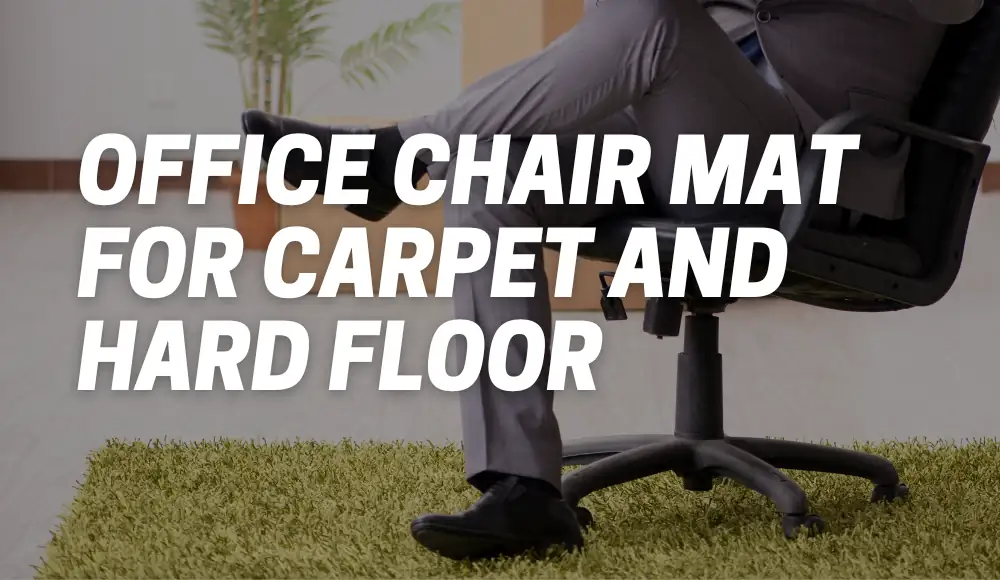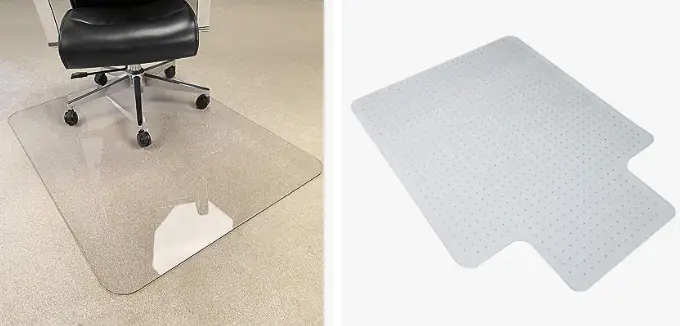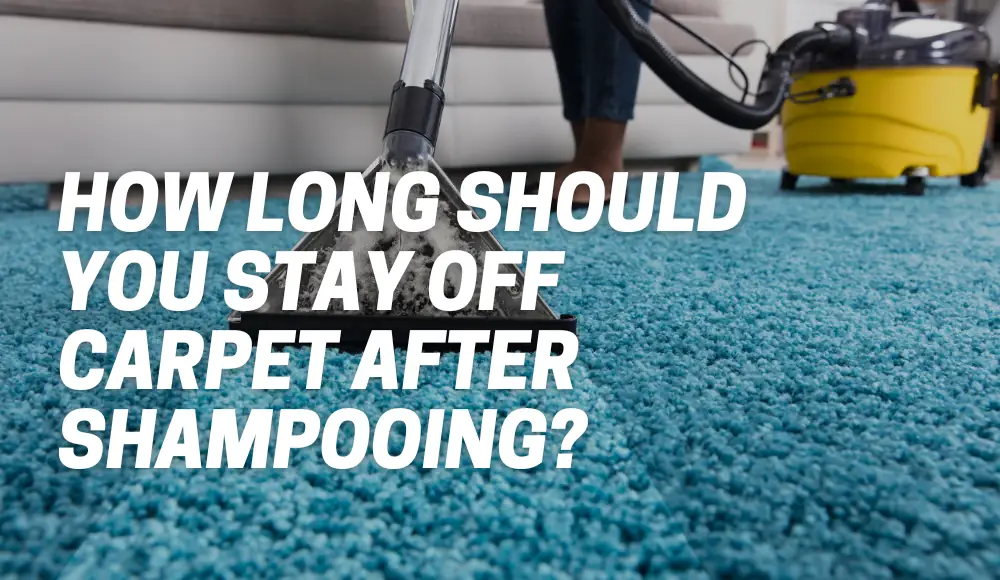Last updated on October 18th, 2023 at 03:07 am
If you’re someone who spends long hours at a desk, you know the importance of having a comfortable workspace. One essential component of that workspace is often overlooked but can make a significant difference in your daily comfort and the longevity of your flooring – the chair mat.
In this guide, we’ll explore everything you need to know about chair mats, focusing on the particular needs of those with carpeted floors. So, let’s dive in and answer some common questions about chair mats for carpeted surfaces.
Do You Need a Floor Mat for Office Chair on Carpet?
If your office or workspace has carpeted flooring, investing in a chair mat is a smart decision.
A chair mat not only protects your carpet from the wear and tear caused by chair casters but also makes it much easier to move your chair around without straining or damaging the carpet fibers.
When you roll your chair over a carpet without a mat, the casters can dig into the carpet, causing it to wear down quickly. Over time, this can result in unsightly and potentially costly damage. Furthermore, pushing a chair without a mat can be a real workout for your arms and back. It’s not only inconvenient but also uncomfortable.
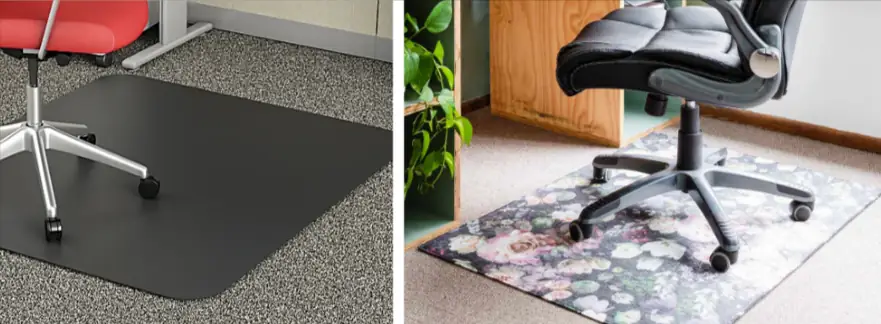
What Do You Put Under an Office Chair on Carpet?
The answer to this question is straightforward: a chair mat.
Chair mats are designed specifically for this purpose. They come in various shapes, sizes, and materials, but their primary function remains the same – to provide a smooth surface for your chair to roll on, protecting your carpet in the process.
Chair mats are typically made from materials like vinyl or polycarbonate, which are durable and can withstand the pressure exerted by chair casters. They also have a textured underside that prevents slipping on the carpet.
Can I Use an Office Chair Mat on Carpet?
Yes, you can and should use an office chair mat on carpet.
It’s the best way to protect your carpet from the wear and tear caused by chair casters. However, it’s essential to choose the right chair mat designed specifically for carpeted surfaces. Using a chair mat meant for hard floors on carpet may not provide the necessary support and could lead to damage.
Are Carpet Chair Mats Worth It?
Without a doubt, chair mats for carpet are a worthwhile investment.
Here are a few reasons why they are worth considering:
- Floor Protection: As mentioned earlier, chair mats protect your carpet from the damaging effects of chair casters. This can extend the life of your carpet and save you money in the long run.
- Ease of Movement: Chair mats create a smooth surface, making it effortless to move your chair around. This can improve your productivity and reduce the risk of strain or injury.
- Aesthetic Appeal: Chair mats come in various styles, including transparent options that allow your carpet’s beauty to shine through. They can enhance the overall appearance of your workspace.
- Cleanliness: Chair mats make it easier to clean up spills and crumbs since they provide a flat surface that can be wiped clean. This helps maintain a tidy workspace.
- Noise Reduction: Chair mats can reduce the noise created by chair casters rolling on carpet, creating a quieter work environment.
Are Chair Mats Better for Hard Floors or Carpet?
Chair mats serve different purposes for hard floors and carpeted surfaces. For hard floors like wood, tile, or laminate, chair mats protect the floor from scratches and scuffs caused by chair casters. They also provide a smooth surface for chair movement.
On the other hand, for carpeted floors, chair mats primarily protect the carpet from being compressed and damaged by the weight of the chair and its casters. They also make it easier to move the chair without exerting excessive force.
So, the choice between a chair mat for hard floors or carpet depends on your specific needs. In this article, we’re focusing on chair mats for carpeted floors.
What Is the Difference Between Office Chair Mat for Carpet and Hard Floor?
The main difference between chair mats for carpet and hard floors lies in their design and materials.
Here’s a breakdown of the key distinctions:
- Materials: Chair mats for carpeted floors are typically made from thicker and more flexible materials to provide proper support and protection on carpeting. They often have small spikes or studs on the underside to grip the carpet and prevent slipping. In contrast, chair mats for hard floors are usually thinner and made from materials like PVC or polycarbonate.
- Texture: Carpet chair mats have a textured surface to allow smooth chair movement on the carpet while providing stability. Chair mats for hard floors have a smoother surface to prevent scratching or damaging the floor.
- Thickness: Chair mats for carpet are thicker to provide the necessary support and protection for carpeted surfaces. Chair mats for hard floors are thinner since they don’t need to accommodate the uneven texture of carpeting.
- Edges: Chair mats for carpet often have beveled edges to make it easy to roll on and off the mat without getting stuck. Chair mats for hard floors typically have straight or slightly raised edges to contain any spills.
- Weight Capacity: Carpet chair mats are designed to distribute the weight of the chair and the person using it evenly across the carpet. Hard floor chair mats have a different weight distribution design suitable for hard surfaces.
How Do I Choose an Office Chair Mat?
Selecting the right chair mat for your carpeted floor involves considering a few key factors:
- Size: Measure the area under your desk where you intend to place the chair mat. Make sure to choose a mat that covers the entire space where your chair moves.
- Thickness: Chair mats for carpeted floors come in various thicknesses. Thicker mats offer more support and protection for your carpet. Choose a thickness that suits your needs and budget.
- Material: Look for chair mats made from durable materials like vinyl or polycarbonate. Ensure it has small studs or spikes on the underside to grip the carpet.
- Shape: Chair mats come in different shapes, such as rectangular, square, and contour. Choose one that fits your workspace layout and personal preferences.
- Weight Capacity: Check the weight capacity of the chair mat to ensure it can handle the weight of your chair and your body.
- Edges: Consider whether you prefer a chair mat with beveled edges for easy rolling on and off or straight edges for spill containment.
- Aesthetic: Some chair mats are transparent, while others have designs or patterns. Choose one that complements your office decor.
How Thick Should a Chair Mat Be for Carpet?
The thickness of a chair mat for carpet depends on your specific needs and the type of carpet you have. Generally, chair mats for carpet come in thicknesses ranging from 0.08 inches (2mm) to 0.25 inches (6mm).
- Thin Mats (2-3mm): These are suitable for low-pile carpets. They provide basic protection and are more affordable.
- Medium Mats (3-4mm): These work well for medium-pile carpets. They offer better support and durability.
- Thick Mats (5-6mm): Thick chair mats are a good choice for high-pile or plush carpets. They provide excellent protection and support.
Choosing the right thickness ensures that your chair mat effectively protects your carpet and provides a smooth surface for chair movement.
Office chair mat for carpeted floor
What Can I Use Instead of an Office Chair Mat?
If you’re looking for an alternative to a traditional chair mat, consider these options:
- Carpet Protector Film: This adhesive film sticks to your carpet and creates a smooth surface for chair movement. It’s a temporary solution and may need replacement over time.
- Plywood or Hardboard: Placing a sheet of plywood or hardboard under your chair can offer a flat surface for chair movement. However, this option may not protect your carpet as effectively as a chair mat designed for the purpose.
- Carpet Remnants: If you have spare carpet remnants, you can cut them to size and place them under your chair. While this is a low-cost option, it may not provide the same level of durability as a chair mat.
- DIY Chair Mat: If you’re feeling crafty, you can create your own chair mat using materials like clear plastic or acrylic. This allows you to customize the size and shape to your liking.
Remember that these alternatives may not offer the same level of protection, durability, and ease of use as a purpose-made chair mat.
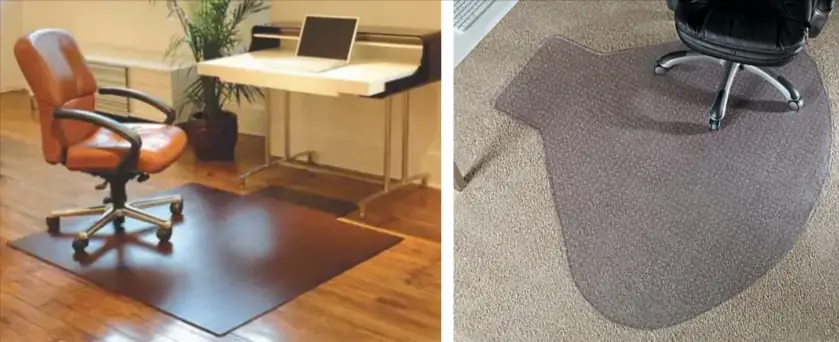
What Type of Chair Mat Is Best for Hardwood Floors?
While this article primarily focuses on chair mats for carpet, it’s essential to briefly touch on chair mats for hardwood floors. If you have hardwood or other hard surface flooring, you’ll want a chair mat designed specifically for this purpose. Here are a few considerations:
- Material: Chair mats for hardwood floors are typically made from PVC or polycarbonate, which are gentle on hardwood surfaces and prevent scratching.
- Thickness: Thinner chair mats work well on hard floors as they provide a smooth surface without damaging the floor.
- Texture: Look for chair mats with a smooth surface to avoid scratching your hardwood floors.
- Edges: Straight or slightly raised edges are suitable for containing spills on hard floors.
- Size: Measure the area where you need floor protection to choose the right size.
Conclusion
A chair mat can make a significant difference in your comfort and the longevity of your carpeted floor. It’s a practical investment that not only protects your flooring but also makes your workspace more ergonomic and aesthetically pleasing.
When choosing a chair mat for carpet, consider factors like size, thickness, material, and weight capacity to find the perfect fit for your needs. Don’t hesitate to invest in this essential office accessory for a more comfortable and efficient work environment.
